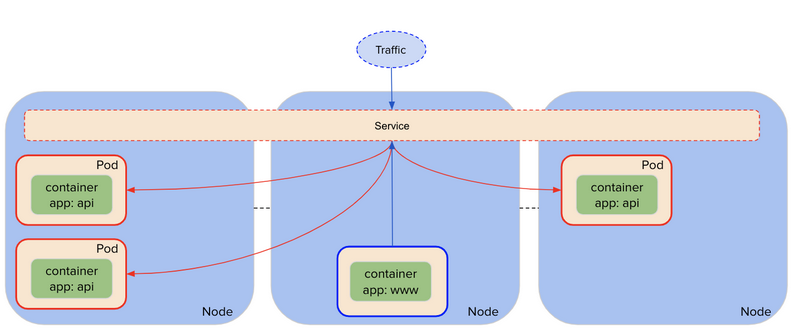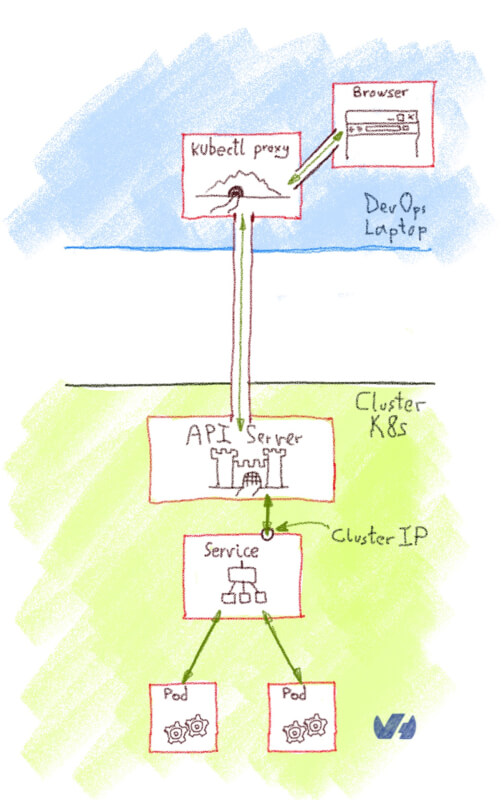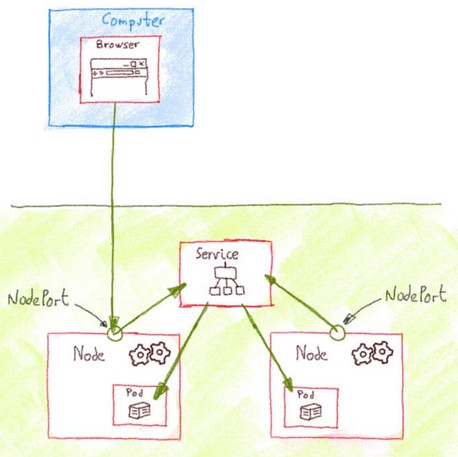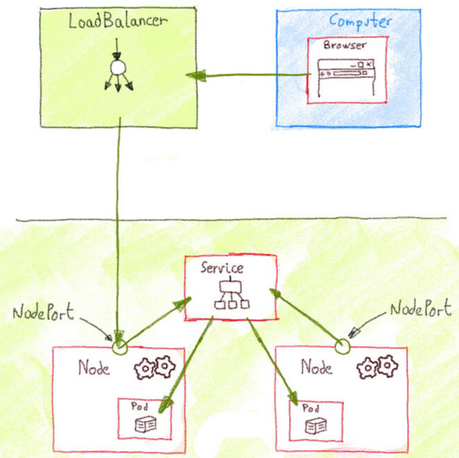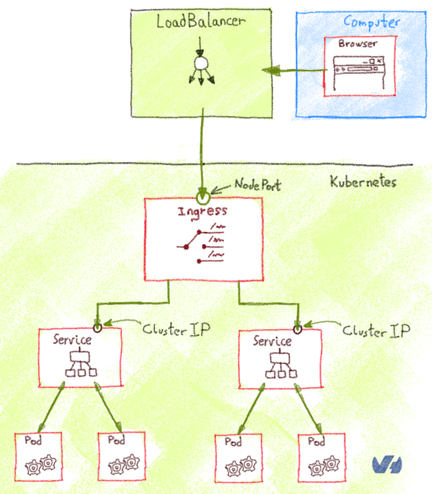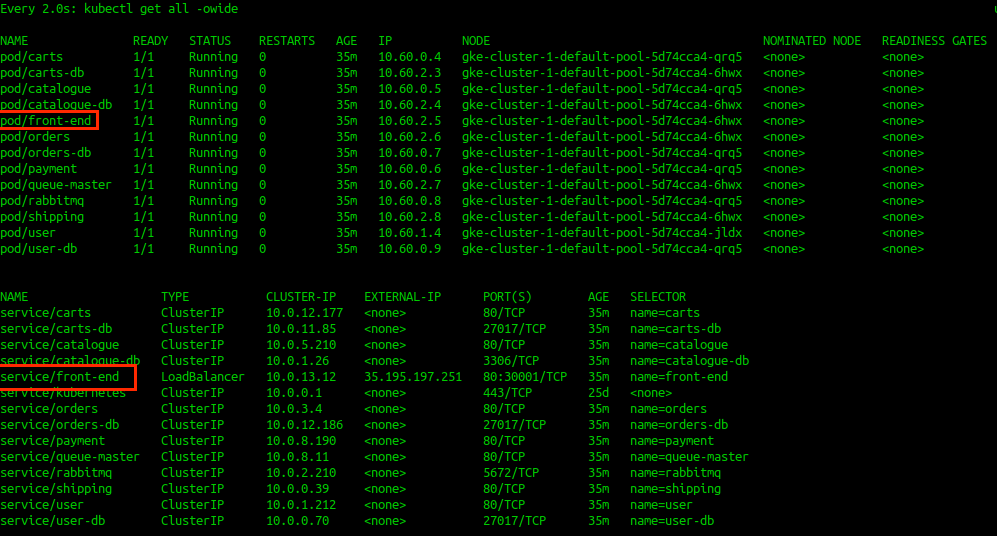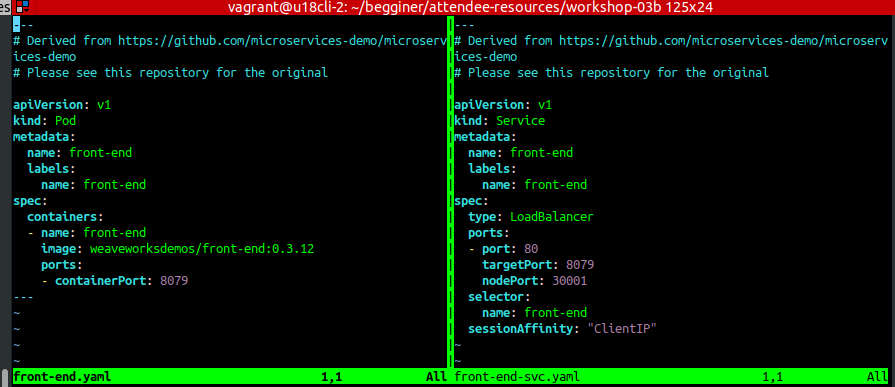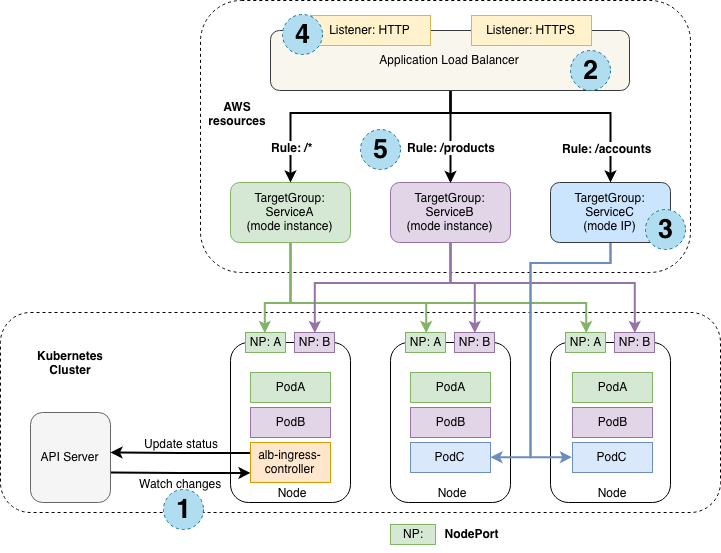Difference between revisions of "Kubernetes/Networking"
(→DNS) |
|||
| (33 intermediate revisions by the same user not shown) | |||
| Line 1: | Line 1: | ||
= ClusterIP = | |||
<code>ClusterIP</code> is the IP for the K8s service which is nothing but a magic of "IP Tables Rules". Kube-Proxy is responsible to write ip table rules in every node once you define <code>Service</code>. These ip table rules or ClusterIP points to actual pod IP(The IP assigned by flannel daemon). | |||
= Pod networking = | = Pod networking = | ||
Networking in Kubernetes is using Linux Network namespace. Each Pod has IP address assosiated with it. It recives this IP from Virtual Ethernet interface pair. | Networking in Kubernetes is using Linux Network namespace. Each Pod has IP address assosiated with it. It recives this IP from Virtual Ethernet interface pair. | ||
| Line 20: | Line 23: | ||
</source> | </source> | ||
;Flannel | |||
<source lang=bash> | |||
$ cat /run/flannel/subnet.env | |||
FLANNEL_NETWORK=100.96.0.0/16 # overlay network, All containers(Pod) will be assigned one ip address in this overlay network, | |||
# they communicate with each other by calling each other’s ip address directly | |||
FLANNEL_SUBNET=100.96.1.1/24 # docker can use it as its bridge network | |||
FLANNEL_MTU=8951 | |||
FLANNEL_IPMASQ=true | |||
</source> | |||
Find out node that 'nginx' pod is running on | Find out node that 'nginx' pod is running on | ||
| Line 119: | Line 131: | ||
#eth0@if6: :- eth0 on a pod is linked to node's 6th interface | #eth0@if6: :- eth0 on a pod is linked to node's 6th interface | ||
</source> | </source> | ||
= Service networking = | |||
= kube-proxy = | |||
The Kubernetes network proxy (aka kube-proxy) is a daemon running on each node. It basically reflects the services defined in the cluster and manages the rules to load-balance requests to a service’s backend pods. | |||
:[[File:ClipCapIt-210604-053707.PNG]] | |||
It can run in a 3 modes, check [https://www.tigera.io/blog/comparing-kube-proxy-modes-iptables-or-ipvs/ comparison of iptables and IPVS modes]: | |||
* iptables (default mode) | |||
* ipvs | |||
* userspace (“legacy” mode, not recommended anymore) | |||
<code>kube-proxy</code> is responsible to write ip table rules in every node once you define Service. These ip table rules or ClusterIP points to actual pod IP(The IP assigned by flannel daemon). | |||
<source lang=bash> | |||
# exec to kube proxy | |||
kuebctl exec -it kube-proxy-12345 -n kube-system -- sh | |||
# check if kueb-proxy is writing iptables rules | |||
sh$ iptables-save | grep <pod-name> | |||
-A KUBE-SERVICES ! -s ... | |||
<TODO:add real output> | |||
</source> | |||
= <code>kind: Service</code> networking = | |||
Services allow our pods to move around, get deleted, and replicate, all without having to manually keep track of their IP addresses in the cluster. This is accomplished by creating one gateway to distribute packets evenly across all pods. | Services allow our pods to move around, get deleted, and replicate, all without having to manually keep track of their IP addresses in the cluster. This is accomplished by creating one gateway to distribute packets evenly across all pods. | ||
In depth: | |||
* [https://kubernetes.io/docs/concepts/services-networking/service/#headless-services Service + diagrams] K8s docs | |||
* [https://stackoverflow.com/questions/50758122/which-service-is-doing-load-balancing-between-kubernetes-nodes/50760654#50760654 Which service is doing load balancing between kubernetes nodes?] iptables rules | |||
* [https://kubernetes.io/docs/concepts/services-networking/service/#proxy-mode-iptables proxy-mode-iptables] K8s docs | |||
* [https://github.com/aws/amazon-vpc-cni-k8s amazon-vpc-cni-k8s] | |||
* [https://cloud.google.com/blog/products/gcp/kubernetes-best-practices-mapping-external-services service.type: externalName] best practices to map external services | |||
YAML for nginx NodePort service | YAML for nginx NodePort service | ||
< | <syntaxhighlightjs lang=yaml> | ||
apiVersion: v1 | apiVersion: v1 | ||
kind: Service | kind: Service | ||
| Line 132: | Line 174: | ||
type: NodePort | type: NodePort | ||
ports: | ports: | ||
- nodePort: 30080 #port on each node | - nodePort: 30080 # port on each node this service is exposed/available through | ||
port: 80 #port | # when type=NodePort or LoadBalancer, by default auto-allocate | ||
port: 80 # inside the cluster, what port this service expose | |||
protocol: TCP | protocol: TCP | ||
targetPort: 80 #port | targetPort: 80 # port on the pods targeted by the service, | ||
# by default the same as 'port', it's the port exposed by containers | |||
selector: | selector: | ||
app: nginx | app: nginx # service will be applied to each pod with this label | ||
</ | </syntaxhighlightjs> | ||
| Line 159: | Line 202: | ||
kubernetes 172.31.115.255:6443 11d | kubernetes 172.31.115.255:6443 11d | ||
nginx 10.100.2.11:80 9d | nginx 10.100.2.11:80 9d | ||
# Another example, showing an application 'rediness-app' is having 3 pods behind its service | |||
$ kubectl get endpoints | |||
NAME ENDPOINTS AGE | |||
kubernetes 35.205.145.199:443 26d | |||
readiness-app 10.60.0.23:8080,10.60.1.9:8080,10.60.2.24:8080 7m6s | |||
</source> | </source> | ||
| Line 173: | Line 222: | ||
</source> | </source> | ||
= | == type: ClusterIP == | ||
:[[File:ClipCapIt-200202-175007.PNG]] | |||
== type: NodePort == | |||
:[[File:ClipCapIt-200202-175203.PNG]] | |||
== type: LoadBalancer == | |||
:[[File:ClipCapIt-200202-175228.PNG]] | |||
== type: ExternalName == | |||
The endpoint resides outside of kubernetes cluster. | |||
= <code>kind: ingress</code> networking = | |||
< | Ingress it is configuration for a reverse-proxy; implementation need to plugged in to Kubernetes eg. deploying <code>nginx-ingress-controller</code>. | ||
:[[File:ClipCapIt-200202-175537.PNG]] | |||
Ingress YAML spec | Ingress YAML spec | ||
< | <syntaxhighlightjs lang=yaml> | ||
cat > ingress.yml <<EOF | cat > ingress.yml <<EOF | ||
apiVersion: extensions/v1beta1 | apiVersion: extensions/v1beta1 | ||
| Line 248: | Line 250: | ||
spec: | spec: | ||
rules: | rules: | ||
- host: acme.example.com #must be valid domain | - host: acme.example.com # must be valid domain | ||
http: | http: | ||
paths: | paths: | ||
| Line 260: | Line 262: | ||
serviceName: nginx-2 | serviceName: nginx-2 | ||
servicePort: 80 | servicePort: 80 | ||
- http: #any traffic not matching HEADER: <hostnames> above | - http: # any traffic not matching HEADER: <hostnames> above | ||
paths: | paths: | ||
- backend: | - backend: | ||
| Line 266: | Line 268: | ||
servicePort: 80 | servicePort: 80 | ||
EOF | EOF | ||
</ | </syntaxhighlightjs> | ||
| Line 275: | Line 277: | ||
</source> | </source> | ||
The generated configuration by Ingress can be seen directly within the ingress provider eg. nginx pod | |||
<source lang=bash> | |||
# _______nginx-ingress-controller-pod______ | |||
kubectl -n ingress-nginx exec nginx-ingress-controller-748cd7b559-wd6rc cat /etc/nginx/nginx.conf > nginx.conf | |||
</source> | |||
= Port-forward = | |||
Forward one or more local ports to a pod. This command requires the node to have <tt>socat</tt> installed. You can port-forward traffic only to a pod selected by service or deployment. This feature is only used for debugging. Examples: | |||
<source lang=bash> | <source lang=bash> | ||
# | # Listen on ports 5000 and 6000 locally, forwarding data to/from ports 5000 and 6000 in the pod /or | ||
# pods selected by a service or deployment | |||
kubectl port-forward pod/mypod 5000 6000 # forwarding to the pod | |||
# | kubectl port-forward service/myservice 5000 6000 # forwarding to a selected (rnd) pod by the service | ||
kubectl port-forward deployment/mydeployment 5000 6000 # forwarding to a selected (rnd) pod by the deployment | |||
# Listen on port 8888 locally, forwarding to 5000 in the pod | |||
kubectl port-forward pod/mypod 8888:5000 | |||
kubectl port-forward service/kibana --address=0.0.0.0 8888:5000 # listen on all IPs | |||
</source> | </source> | ||
This is a status of deployed applications, note frond-end application, we are trying to access localy | |||
:[[File:ClipCapIt-190808-125724.PNG]] | |||
We can port-forward remote kubernetes service port to local machine. Let's assume we have config like this: | |||
:[[File:ClipCapIt-190808-125049.PNG]] | |||
Create port-forwarding, your host will start listening on port TCP:8079. If your pod is exposing port below <1024 you should then you need to specify local port to target pod, then use eg: <code>8089:80</code>. First port is local port, second is the container port. | |||
<source lang=bash> | <source lang=bash> | ||
kubectl - | $> kubectl port-forward front-end 8079 | ||
Forwarding from 127.0.0.1:8079 -> 8079 | |||
Forwarding from [::1]:8079 -> 8079 | |||
Handling connection for 8079 | |||
# In a new terminal try to reach to the frond-end | |||
$> curl http://localhost:8079 | |||
</source> | |||
;References: | |||
*[https://kubernetes.github.io/ingress-nginx/user-guide/multiple-ingress/ Multiple Ingress controllers] nGinx | |||
= Proxy = | |||
Creates a proxy server or application-level gateway between localhost and the Kubernetes API Server. It also allows serving static content over specified HTTP path. All incoming data enters through one port and gets forwarded to the remote kubernetes API Server port, except for the path matching the static content path. | |||
<source lang=bash> | |||
# Proxy all of the kubernetes api and nothing else | |||
kubectl proxy --api-prefix=/ | |||
</source> | </source> | ||
= Ssh to node = | |||
<source> | |||
gcloud compute ssh gke-cluster-1-default-pool-5d74cca4-6hwx | |||
$ gcloud compute ssh gke-cluster-1-default-pool-5d74cca4-6hwx | |||
WARNING: The public SSH key file for gcloud does not exist. | |||
WARNING: The private SSH key file for gcloud does not exist. | |||
WARNING: You do not have an SSH key for gcloud. | |||
WARNING: SSH keygen will be executed to generate a key. | |||
Generating public/private rsa key pair. | |||
Enter passphrase (empty for no passphrase): | |||
Enter same passphrase again: | |||
Your identification has been saved in /home/vagrant/.ssh/google_compute_engine. | |||
Your public key has been saved in /home/vagrant/.ssh/google_compute_engine.pub. | |||
The key fingerprint is: | |||
SHA256:V8S2tzis6NPGfFdKzUak0IX0aRUBin3jW+wCMFqfoYA vagrant@u18cli-2 | |||
The key's randomart image is: | |||
+---[RSA 2048]----+ | |||
| ..+o==| | |||
| . o.= o.+| | |||
| E . = =.= =.| | |||
| + =.* * .| | |||
| .S..= + B | | |||
| . = * =| | |||
| = . = = | | |||
| o * . + | | |||
| ..o . . | | |||
+----[SHA256]-----+ | |||
Updating project ssh metadata...⠹Updated [https://www.googleapis.com/compute/v1/projects/responsive-sun-246311]. | |||
Updating project ssh metadata...done. | |||
Waiting for SSH key to propagate. | |||
Warning: Permanently added 'compute.7391123279603721012' (ECDSA) to the list of known hosts. | |||
############################################################################## | |||
# WARNING: Any changes on the boot disk of the node must be made via | |||
# DaemonSet in order to preserve them across node (re)creations. | |||
# Node will be (re)created during manual-upgrade, auto-upgrade, | |||
# auto-repair or auto-scaling. | |||
# See https://cloud.google.com/kubernetes-engine/docs/concepts/node-images#modifications | |||
# for more information. | |||
############################################################################## | |||
Welcome to Ubuntu 18.04.2 LTS (GNU/Linux 4.15.0-1034-gke x86_64) | |||
* Documentation: https://help.ubuntu.com | |||
* Management: https://landscape.canonical.com | |||
* Support: https://ubuntu.com/advantage | |||
This system has been minimized by removing packages and content that are | |||
not required on a system that users do not log into. | |||
To restore this content, you can run the 'unminimize' command. | |||
0 packages can be updated. | |||
0 updates are security updates. | |||
Welcome to Kubernetes v1.13.7-gke.8! | |||
You can find documentation for Kubernetes at: | |||
http://docs.kubernetes.io/ | |||
The source for this release can be found at: | |||
/home/kubernetes/kubernetes-src.tar.gz | |||
Or you can download it at: | |||
https://storage.googleapis.com/kubernetes-release-gke/release/v1.13.7-gke.8/kubernetes-src.tar.gz | |||
It is based on the Kubernetes source at: | |||
https://github.com/kubernetes/kubernetes/tree/v1.13.7-gke.8 | |||
For Kubernetes copyright and licensing information, see: | |||
/home/kubernetes/LICENSES | |||
</source> | |||
# | = [[Kubernetes/Security#Network policies | Network policies]] = | ||
= LoadBalancer networking = | |||
Loadbalancer is an extension of NodePort type of service. Loadbalancer redirect traffic to all nodes and NodePort. LoadBalancers are not pod aware, as nodes are its backend. The traffic to the right ''pod'' is controlled by IPtables. See below. If request from LoadBalancer is sent to Node-3, to reach a pod:80. There is no pod serving port 80 on Node-3. Therefore IPTables will route traffic to another node here: Node-1 or 2 (this is overlay network). Then the reply, will be routed back to Node-3 and out through LoadBalancer. This all means extra hops and latency. | |||
<source> | |||
. | |||
LoadBalancer | |||
IP: 22.111.222.33 | |||
/ | \ | |||
Node-1 Node-2 Node-3 | |||
172.10.10.11 172.10.11.22 172.10.12.33 | |||
NodePort:33623 NodePort:33623 NodePort:33623 | |||
Service:8080:80 Service:8080:80 Service:8080:80 | |||
pod1 10.100.1.1:80 pod4 10.100.2.1:80 pod6 10.100.3.1:81 | |||
pod2 10.100.1.2:81 pod5 10.100.2.2:81 | |||
pod3 10.100.1.3:82 | |||
</source> | |||
LoadBalancer YAML spec. NodePort is not specifed as K8s will assign one and will manage it. | |||
<source lang=yaml> | <source lang=yaml> | ||
apiVersion: v1 | apiVersion: v1 | ||
kind: Service | kind: Service | ||
metadata: | metadata: | ||
name: | name: nginx-loadbalancer | ||
spec: | spec: | ||
type: LoadBalancer | |||
ports: | ports: | ||
- port: 80 | - port: 80 | ||
targetPort: | targetPort: 80 | ||
selector: | selector: | ||
app: | app: nginx | ||
</source> | </source> | ||
Create a loadbalancer by exposing a deployment | |||
<source lang= | <source lang=bash> | ||
kubectl run nginx-loadbalancer --image=nginx | |||
kubectl scale deployment/nginx-loadbalancer --replicas=2 | |||
kubectl expose deployment nginx-loadbalancer --port 80 --target-port 8080 --type LoadBalancer | |||
# / \ | |||
# exposed port pod port | |||
# curl nginx-loadbalancer:80 curl <pod-ip>:8080 | |||
</source> | </source> | ||
Influence traffic flow | |||
<source lang=bash> | <source lang=bash> | ||
kubectl - | kubectl describe service nginx-loadbalancer | ||
Name: nginx-loadbalancer | |||
Namespace: default | |||
Labels: run=nginx-loadbalancer | |||
Annotations: <none> # annotated -> ExternalTrafficPolicy: Local | |||
Selector: run=nginx-loadbalancer | |||
Type: LoadBalancer | |||
IP: 10.97.188.223 | |||
Port: <unset> 80/TCP | |||
TargetPort: 8080/TCP | |||
NodePort: <unset> 31154/TCP | |||
Endpoints: 10.100.1.10:8080 | |||
Session Affinity: None | |||
External Traffic Policy: Cluster | |||
Events: <none> | |||
# | # add annotation, so traffic is routed to a pod on a local node if exists. | ||
kubectl annotate service nginx-loadbalancer ExternalTrafficPolicy=Local | |||
</source> | </source> | ||
= Summary diagram of AWS Kubernetes networking = | |||
:[[File:ClipCapIt-190716-085801.PNG]] | |||
= Session affinity in Kubernetes = | |||
By default applications run on Kubernetes should be stateless therefore pods deployed with <code>Deployment</code> are expected to eb stateless. | |||
== Pod to Service routing - [https://kubernetes.io/docs/concepts/services-networking/service/#proxy-mode-userspace sessionAffinity] Kubernetes buildin == | |||
When a pod in a cluster does an http request to a Service within the cluster, the kube-proxy does routing in a round robin way by default. If you want session affinity on pod-to-service routing, you can set the <code>SessionAffinity: ClusterIP</code> field on a <code>Service</code> object. It make sure that connections from a particular client are passed to the same Pod each time, you can select the session affinity based on the client’s IP addresses. This is not very scalable as requests coming from the same IP will end up on the same pod, eg. behind NAT. | |||
<source lang=bash> | |||
kubectl patch service myapp --patch '{"spec":{"sessionAffinity":"ClientIP","sessionAffinityConfig":{"clientIP":{"timeoutSeconds":30}}}}' | |||
kubectl patch service myapp --patch "$(cat service-patch.yaml)" | |||
</source> | |||
<source lang=yaml> | |||
# service-patch.yaml | |||
spec: | |||
sessionAffinity: ClientIP | |||
sessionAffinityConfig: | |||
clientIP: | |||
timeoutSeconds: 30 # default is 10800 | |||
</source> | |||
== Ingress to Service routing == | |||
Ingress-nginx, Istio have support for sticky sessions. | |||
= Troubleshooting = | |||
* [https://gravitational.com/blog/troubleshooting-kubernetes-networking troubleshooting-kubernetes-networking] gravitational.com | |||
= References = | = References = | ||
*Trafic routing | |||
**[https://www.ovh.com/blog/getting-external-traffic-into-kubernetes-clusterip-nodeport-loadbalancer-and-ingress/ Getting external traffic into Kubernetes] OVH blog | |||
*Service | *Service | ||
**[https://kubernetes.io/docs/concepts/services-networking/service/ Service] k8s docs | **[https://kubernetes.io/docs/concepts/services-networking/service/ Service] k8s docs | ||
Latest revision as of 06:39, 4 June 2021
ClusterIP
ClusterIP is the IP for the K8s service which is nothing but a magic of "IP Tables Rules". Kube-Proxy is responsible to write ip table rules in every node once you define Service. These ip table rules or ClusterIP points to actual pod IP(The IP assigned by flannel daemon).
Pod networking
Networking in Kubernetes is using Linux Network namespace. Each Pod has IP address assosiated with it. It recives this IP from Virtual Ethernet interface pair.
Pod to pod communication on the same node. The pod cidr range was decided during cluster creation kubeadm init --pod-network=10.100.0.0/16 and notified CNI plugin (eg. Flannel, Calico) to use this IP range.
node-1
---pod1--- ---pod2---
|10.100.2.9| |10.100.2.7|
| eth0|----vethc3428d55 vethe10ac769----|eth0 |
---------- \ / ----------
bridge 10.100.2.1/24
|
eth0(node-1)172.31.11.11
---------|=====CNI overlay====|---------------------network--------------
eth0(node-2)172.31.22.22
| ---pod3---
| |10.100.1.5|
\------bridge-----------vetha1bbccdd----|eth0 |
----------
- Flannel
$ cat /run/flannel/subnet.env
FLANNEL_NETWORK=100.96.0.0/16 # overlay network, All containers(Pod) will be assigned one ip address in this overlay network,
# they communicate with each other by calling each other’s ip address directly
FLANNEL_SUBNET=100.96.1.1/24 # docker can use it as its bridge network
FLANNEL_MTU=8951
FLANNEL_IPMASQ=true
Find out node that 'nginx' pod is running on
kubectl -n default get pods -owide NAME READY STATUS RESTARTS AGE IP NODE NOMINATED NODE READINESS GATES nginx-7cdbd8cdc9-89zcf 1/1 Running 1 8d 10.100.2.9 worker-2.acme.com <none> <none>
Ssh to worker-2.acme.com
user@worker-2:~$ ifconfig
cni0 Link encap:Ethernet HWaddr 86:5d:c7:93:72:d2
inet addr:10.100.2.1 Bcast:0.0.0.0 Mask:255.255.255.0
inet6 addr: fe80::845d:c7ff:fe93:72d2/64 Scope:Link
UP BROADCAST RUNNING MULTICAST MTU:8951 Metric:1
RX packets:29 errors:0 dropped:0 overruns:0 frame:0
TX packets:64 errors:0 dropped:0 overruns:0 carrier:0
collisions:0 txqueuelen:1000
RX bytes:1900 (1.9 KB) TX bytes:7165 (7.1 KB)
docker0 Link encap:Ethernet HWaddr 02:42:c7:1c:b8:23
inet addr:172.17.0.1 Bcast:172.17.255.255 Mask:255.255.0.0
UP BROADCAST MULTICAST MTU:1500 Metric:1
RX packets:0 errors:0 dropped:0 overruns:0 frame:0
TX packets:0 errors:0 dropped:0 overruns:0 carrier:0
collisions:0 txqueuelen:0
RX bytes:0 (0.0 B) TX bytes:0 (0.0 B)
eth0 Link encap:Ethernet HWaddr 02:20:2e:90:a8:66
inet addr:172.31.122.65 Bcast:172.31.127.255 Mask:255.255.240.0
inet6 addr: 2a05:d018:85:e101:2177:162b:63d9:3600/128 Scope:Global
inet6 addr: fe80::20:2eff:fe90:a866/64 Scope:Link
UP BROADCAST RUNNING MULTICAST MTU:9001 Metric:1
RX packets:20293 errors:0 dropped:0 overruns:0 frame:0
TX packets:15985 errors:0 dropped:0 overruns:0 carrier:0
collisions:0 txqueuelen:1000
RX bytes:15733611 (15.7 MB) TX bytes:2550893 (2.5 MB)
flannel.1 Link encap:Ethernet HWaddr b2:3a:21:03:ec:13
inet addr:10.100.2.0 Bcast:0.0.0.0 Mask:255.255.255.255
UP BROADCAST RUNNING MULTICAST MTU:8951 Metric:1
RX packets:0 errors:0 dropped:0 overruns:0 frame:0
TX packets:0 errors:0 dropped:20 overruns:0 carrier:0
collisions:0 txqueuelen:0
RX bytes:0 (0.0 B) TX bytes:0 (0.0 B)
lo Link encap:Local Loopback
inet addr:127.0.0.1 Mask:255.0.0.0
inet6 addr: ::1/128 Scope:Host
UP LOOPBACK RUNNING MTU:65536 Metric:1
RX packets:4741 errors:0 dropped:0 overruns:0 frame:0
TX packets:4741 errors:0 dropped:0 overruns:0 carrier:0
collisions:0 txqueuelen:1
RX bytes:543426 (543.4 KB) TX bytes:543426 (543.4 KB)
vethc3428d55 Link encap:Ethernet HWaddr 52:1e:12:8c:0d:34 #<- 6th interface
inet6 addr: fe80::501e:12ff:fe8c:d34/64 Scope:Link #its a pipe to the running pod
UP BROADCAST RUNNING MULTICAST MTU:8951 Metric:1
RX packets:28 errors:0 dropped:0 overruns:0 frame:0
TX packets:94 errors:0 dropped:0 overruns:0 carrier:0
collisions:0 txqueuelen:0
RX bytes:2264 (2.2 KB) TX bytes:10623 (10.6 KB)
vethe10ac769 Link encap:Ethernet HWaddr 56:b5:d4:48:33:cc
inet6 addr: fe80::54b5:d4ff:fe48:33cc/64 Scope:Link
UP BROADCAST RUNNING MULTICAST MTU:8951 Metric:1
RX packets:1 errors:0 dropped:0 overruns:0 frame:0
TX packets:76 errors:0 dropped:0 overruns:0 carrier:0
collisions:0 txqueuelen:0
RX bytes:42 (42.0 B) TX bytes:9190 (9.1 KB)
See containers running on this node. The "/pause" container which pertains to nGinx container for the purpose of holding on to the pods network namespace.
sudo docker ps | grep nginx
CONTAINER ID IMAGE COMMAND CREATED STATUS PORTS NAMES
1fc1244ca7d5 nginx "nginx -g" 44 minu Up 44 k8s_nginx_nginx-7cdbd8cdc9-89zcf_default_9c89e271-a07c-11e9-80e8-02f78428aaf6_2
367062cd2852 k8s.gcr.io/pause:3.1 "/pause" 44 minu Up 44 k8s_POD_nginx-7cdbd8cdc9-89zcf_default_9c89e271-a07c-11e9-80e8-02f78428aaf6_10
#See docker IP (has not worked)
docker inspect --format='{{range .NetworkSettings.Networks}}{{.IPAddress}}{{end}}' $INSTANCE_ID
#See the container PID
sudo docker inspect --format '{{ .State.Pid }}' 1fc1244ca7d5
5738
$ sudo nsenter -t 5738 -n ip addr #display the container networking
1: lo: <LOOPBACK,UP,LOWER_UP> mtu 65536 qdisc noqueue state UNKNOWN group default qlen 1
link/loopback 00:00:00:00:00:00 brd 00:00:00:00:00:00
inet 127.0.0.1/8 scope host lo
valid_lft forever preferred_lft forever
3: eth0@if6: <BROADCAST,MULTICAST,UP,LOWER_UP> mtu 8951 qdisc noqueue state UP group default
link/ether 9e:3a:d3:66:46:bb brd ff:ff:ff:ff:ff:ff link-netnsid 0
inet 10.100.2.9/24 scope global eth0
valid_lft forever preferred_lft forever
#eth0@if6: :- eth0 on a pod is linked to node's 6th interface
kube-proxy
The Kubernetes network proxy (aka kube-proxy) is a daemon running on each node. It basically reflects the services defined in the cluster and manages the rules to load-balance requests to a service’s backend pods.
It can run in a 3 modes, check comparison of iptables and IPVS modes:
- iptables (default mode)
- ipvs
- userspace (“legacy” mode, not recommended anymore)
kube-proxy is responsible to write ip table rules in every node once you define Service. These ip table rules or ClusterIP points to actual pod IP(The IP assigned by flannel daemon).
# exec to kube proxy kuebctl exec -it kube-proxy-12345 -n kube-system -- sh # check if kueb-proxy is writing iptables rules sh$ iptables-save | grep <pod-name> -A KUBE-SERVICES ! -s ... <TODO:add real output>
kind: Service networking
Services allow our pods to move around, get deleted, and replicate, all without having to manually keep track of their IP addresses in the cluster. This is accomplished by creating one gateway to distribute packets evenly across all pods.
In depth:
- Service + diagrams K8s docs
- Which service is doing load balancing between kubernetes nodes? iptables rules
- proxy-mode-iptables K8s docs
- amazon-vpc-cni-k8s
- service.type: externalName best practices to map external services
YAML for nginx NodePort service
<syntaxhighlightjs lang=yaml>
apiVersion: v1
kind: Service
metadata:
name: nginx-nodeport
spec:
type: NodePort
ports:
- nodePort: 30080 # port on each node this service is exposed/available through
# when type=NodePort or LoadBalancer, by default auto-allocate
port: 80 # inside the cluster, what port this service expose
protocol: TCP
targetPort: 80 # port on the pods targeted by the service,
# by default the same as 'port', it's the port exposed by containers
selector:
app: nginx # service will be applied to each pod with this label
</syntaxhighlightjs>
Service has been created on every node to listen on port 30080
sudo lsof -i6 | grep 30080 kube-prox 3202 root 9u IPv6 52872 0t0 TCP *:30080 (LISTEN)
Service and endpoint can be seem below
kubectl get service nginx -owide NAME TYPE CLUSTER-IP EXTERNAL-IP PORT(S) AGE SELECTOR nginx NodePort 10.110.225.169 <none> 80:30080/TCP 9d run=nginx kubectl get endpoints -owide NAME ENDPOINTS AGE kubernetes 172.31.115.255:6443 11d nginx 10.100.2.11:80 9d # Another example, showing an application 'rediness-app' is having 3 pods behind its service $ kubectl get endpoints NAME ENDPOINTS AGE kubernetes 35.205.145.199:443 26d readiness-app 10.60.0.23:8080,10.60.1.9:8080,10.60.2.24:8080 7m6s
iptables associated with the service above can be seen below
sudo iptables-save | grep KUBE | grep nginx -A KUBE-NODEPORTS -p tcp -m comment --comment "default/nginx:" -m tcp --dport 30080 -j KUBE-MARK-MASQ -A KUBE-NODEPORTS -p tcp -m comment --comment "default/nginx:" -m tcp --dport 30080 -j KUBE-SVC-4N57TFCL4MD7ZTDA -A KUBE-SERVICES ! -s 10.100.0.0/16 -d 10.110.225.169/32 -p tcp -m comment --comment "default/nginx: cluster IP" -m tcp --dport 80 -j KUBE-MARK-MASQ #anything from -source (pod cidr 10.100.0.0/16, this will come from nginx service endpoint 10.100.2.11:80) #-destined to the service (nginx NodePort ip 10.110.225.169) redirect with a random pod associated with this service -A KUBE-SERVICES -d 10.110.225.169/32 -p tcp -m comment --comment "default/nginx: cluster IP" -m tcp --dport 80 -j KUBE-SVC-4N57TFCL4MD7ZTDA
type: ClusterIP
type: NodePort
type: LoadBalancer
type: ExternalName
The endpoint resides outside of kubernetes cluster.
kind: ingress networking
Ingress it is configuration for a reverse-proxy; implementation need to plugged in to Kubernetes eg. deploying nginx-ingress-controller.
Ingress YAML spec
<syntaxhighlightjs lang=yaml>
cat > ingress.yml <<EOF
apiVersion: extensions/v1beta1
kind: Ingress
metadata:
name: service-ingress
spec:
rules:
- host: acme.example.com # must be valid domain
http:
paths:
- backend:
serviceName: nginx-1
servicePort: 80
- host: app.example.com
http:
paths:
- backend:
serviceName: nginx-2
servicePort: 80
- http: # any traffic not matching HEADER: <hostnames> above
paths:
- backend:
serviceName: httpd-3
servicePort: 80
EOF </syntaxhighlightjs>
Resource can be managed like any other K8s resources
kubectl apply -f ingress kubectl edit ingress service-ingress
The generated configuration by Ingress can be seen directly within the ingress provider eg. nginx pod
# _______nginx-ingress-controller-pod______ kubectl -n ingress-nginx exec nginx-ingress-controller-748cd7b559-wd6rc cat /etc/nginx/nginx.conf > nginx.conf
Port-forward
Forward one or more local ports to a pod. This command requires the node to have socat installed. You can port-forward traffic only to a pod selected by service or deployment. This feature is only used for debugging. Examples:
# Listen on ports 5000 and 6000 locally, forwarding data to/from ports 5000 and 6000 in the pod /or # pods selected by a service or deployment kubectl port-forward pod/mypod 5000 6000 # forwarding to the pod kubectl port-forward service/myservice 5000 6000 # forwarding to a selected (rnd) pod by the service kubectl port-forward deployment/mydeployment 5000 6000 # forwarding to a selected (rnd) pod by the deployment # Listen on port 8888 locally, forwarding to 5000 in the pod kubectl port-forward pod/mypod 8888:5000 kubectl port-forward service/kibana --address=0.0.0.0 8888:5000 # listen on all IPs
This is a status of deployed applications, note frond-end application, we are trying to access localy
We can port-forward remote kubernetes service port to local machine. Let's assume we have config like this:
Create port-forwarding, your host will start listening on port TCP:8079. If your pod is exposing port below <1024 you should then you need to specify local port to target pod, then use eg: 8089:80. First port is local port, second is the container port.
$> kubectl port-forward front-end 8079 Forwarding from 127.0.0.1:8079 -> 8079 Forwarding from [::1]:8079 -> 8079 Handling connection for 8079 # In a new terminal try to reach to the frond-end $> curl http://localhost:8079
- References
Proxy
Creates a proxy server or application-level gateway between localhost and the Kubernetes API Server. It also allows serving static content over specified HTTP path. All incoming data enters through one port and gets forwarded to the remote kubernetes API Server port, except for the path matching the static content path.
# Proxy all of the kubernetes api and nothing else kubectl proxy --api-prefix=/
Ssh to node
gcloud compute ssh gke-cluster-1-default-pool-5d74cca4-6hwx $ gcloud compute ssh gke-cluster-1-default-pool-5d74cca4-6hwx WARNING: The public SSH key file for gcloud does not exist. WARNING: The private SSH key file for gcloud does not exist. WARNING: You do not have an SSH key for gcloud. WARNING: SSH keygen will be executed to generate a key. Generating public/private rsa key pair. Enter passphrase (empty for no passphrase): Enter same passphrase again: Your identification has been saved in /home/vagrant/.ssh/google_compute_engine. Your public key has been saved in /home/vagrant/.ssh/google_compute_engine.pub. The key fingerprint is: SHA256:V8S2tzis6NPGfFdKzUak0IX0aRUBin3jW+wCMFqfoYA vagrant@u18cli-2 The key's randomart image is: +---[RSA 2048]----+ | ..+o==| | . o.= o.+| | E . = =.= =.| | + =.* * .| | .S..= + B | | . = * =| | = . = = | | o * . + | | ..o . . | +----[SHA256]-----+ Updating project ssh metadata...⠹Updated [https://www.googleapis.com/compute/v1/projects/responsive-sun-246311]. Updating project ssh metadata...done. Waiting for SSH key to propagate. Warning: Permanently added 'compute.7391123279603721012' (ECDSA) to the list of known hosts. ############################################################################## # WARNING: Any changes on the boot disk of the node must be made via # DaemonSet in order to preserve them across node (re)creations. # Node will be (re)created during manual-upgrade, auto-upgrade, # auto-repair or auto-scaling. # See https://cloud.google.com/kubernetes-engine/docs/concepts/node-images#modifications # for more information. ############################################################################## Welcome to Ubuntu 18.04.2 LTS (GNU/Linux 4.15.0-1034-gke x86_64) * Documentation: https://help.ubuntu.com * Management: https://landscape.canonical.com * Support: https://ubuntu.com/advantage This system has been minimized by removing packages and content that are not required on a system that users do not log into. To restore this content, you can run the 'unminimize' command. 0 packages can be updated. 0 updates are security updates. Welcome to Kubernetes v1.13.7-gke.8! You can find documentation for Kubernetes at: http://docs.kubernetes.io/ The source for this release can be found at: /home/kubernetes/kubernetes-src.tar.gz Or you can download it at: https://storage.googleapis.com/kubernetes-release-gke/release/v1.13.7-gke.8/kubernetes-src.tar.gz It is based on the Kubernetes source at: https://github.com/kubernetes/kubernetes/tree/v1.13.7-gke.8 For Kubernetes copyright and licensing information, see: /home/kubernetes/LICENSES
Network policies
LoadBalancer networking
Loadbalancer is an extension of NodePort type of service. Loadbalancer redirect traffic to all nodes and NodePort. LoadBalancers are not pod aware, as nodes are its backend. The traffic to the right pod is controlled by IPtables. See below. If request from LoadBalancer is sent to Node-3, to reach a pod:80. There is no pod serving port 80 on Node-3. Therefore IPTables will route traffic to another node here: Node-1 or 2 (this is overlay network). Then the reply, will be routed back to Node-3 and out through LoadBalancer. This all means extra hops and latency.
.
LoadBalancer
IP: 22.111.222.33
/ | \
Node-1 Node-2 Node-3
172.10.10.11 172.10.11.22 172.10.12.33
NodePort:33623 NodePort:33623 NodePort:33623
Service:8080:80 Service:8080:80 Service:8080:80
pod1 10.100.1.1:80 pod4 10.100.2.1:80 pod6 10.100.3.1:81
pod2 10.100.1.2:81 pod5 10.100.2.2:81
pod3 10.100.1.3:82
LoadBalancer YAML spec. NodePort is not specifed as K8s will assign one and will manage it.
apiVersion: v1
kind: Service
metadata:
name: nginx-loadbalancer
spec:
type: LoadBalancer
ports:
- port: 80
targetPort: 80
selector:
app: nginx
Create a loadbalancer by exposing a deployment
kubectl run nginx-loadbalancer --image=nginx kubectl scale deployment/nginx-loadbalancer --replicas=2 kubectl expose deployment nginx-loadbalancer --port 80 --target-port 8080 --type LoadBalancer # / \ # exposed port pod port # curl nginx-loadbalancer:80 curl <pod-ip>:8080
Influence traffic flow
kubectl describe service nginx-loadbalancer Name: nginx-loadbalancer Namespace: default Labels: run=nginx-loadbalancer Annotations: <none> # annotated -> ExternalTrafficPolicy: Local Selector: run=nginx-loadbalancer Type: LoadBalancer IP: 10.97.188.223 Port: <unset> 80/TCP TargetPort: 8080/TCP NodePort: <unset> 31154/TCP Endpoints: 10.100.1.10:8080 Session Affinity: None External Traffic Policy: Cluster Events: <none> # add annotation, so traffic is routed to a pod on a local node if exists. kubectl annotate service nginx-loadbalancer ExternalTrafficPolicy=Local
Summary diagram of AWS Kubernetes networking
Session affinity in Kubernetes
By default applications run on Kubernetes should be stateless therefore pods deployed with Deployment are expected to eb stateless.
Pod to Service routing - sessionAffinity Kubernetes buildin
When a pod in a cluster does an http request to a Service within the cluster, the kube-proxy does routing in a round robin way by default. If you want session affinity on pod-to-service routing, you can set the SessionAffinity: ClusterIP field on a Service object. It make sure that connections from a particular client are passed to the same Pod each time, you can select the session affinity based on the client’s IP addresses. This is not very scalable as requests coming from the same IP will end up on the same pod, eg. behind NAT.
kubectl patch service myapp --patch '{"spec":{"sessionAffinity":"ClientIP","sessionAffinityConfig":{"clientIP":{"timeoutSeconds":30}}}}'
kubectl patch service myapp --patch "$(cat service-patch.yaml)"
# service-patch.yaml
spec:
sessionAffinity: ClientIP
sessionAffinityConfig:
clientIP:
timeoutSeconds: 30 # default is 10800
Ingress to Service routing
Ingress-nginx, Istio have support for sticky sessions.
Troubleshooting
- troubleshooting-kubernetes-networking gravitational.com
References
- Trafic routing
- Service
- Service k8s docs
- DNS
